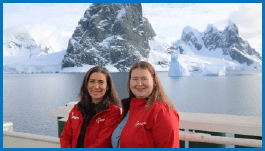Antarctic expedition champions water sustainability, women in STEMM
February 21, 2024

AWWA Articles
Antarctic expedition champions water sustainability, women in STEMM
A global initiative to address climate change, sustainability and leadership diversity drew two intrepid American Water Works Association (AWWA) members into an ocean voyage to the ends of the earth.
 Paula Silva and Shannon Babb, along with 86 women from 18 different countries, embarked on a 19-day expedition out of Ushuaia, Argentina. Their November journey aboard The Ushuaia, a 278-foot ice-strengthened polar research vessel, took them around the northern tip of the Antarctic Peninsula.
Paula Silva and Shannon Babb, along with 86 women from 18 different countries, embarked on a 19-day expedition out of Ushuaia, Argentina. Their November journey aboard The Ushuaia, a 278-foot ice-strengthened polar research vessel, took them around the northern tip of the Antarctic Peninsula.
The adventure was part of the Homeward Bound Projects, an Australia-based global initiative that empowers women in science, technology, engineering, mathematics and medicine (STEMM) by providing leadership training and collaboration opportunities. (Pictured right, Paula Silva and Shannon Babb on their Antarctic adventure.)
After exploring Antarctica and witnessing the urgent need to safeguard it for future generations, Silva and Babb returned determined to make an impact and lead the way in water sustainability.
“The Antarctic ecosystem is an incredible reminder of climate connection and nature interdependency,” said Silva, water resources engineer and project manager at Jacobs. “Antarctica not only holds approximately 60% of the planet’s freshwater but plays a critical role in regulating the planet’s climate, which has a direct impact on water supply. We need to think of Antarctica as ‘One Water’ and support immediate climate action.”
Throughout the journey, participants shared insights about water issues and discussed the need for diverse voices in the sector.
“The most important insight that I gained is the need to have greater diversity in the type of STEMM voices,” said Babb, instructional/curriculum specialist at Central Utah Water Conservancy District in Orem. “Ensuring that there is space for women’s voices is incredibly important in tackling water issues, which is why global projects designed to build bridges and create STEMM communities, such as Homeward Bound, are so important.”
Applying lessons learned
Silva and Babb are already applying their experiences back home.
 “Utah has many parallels with Antarctica,” Babb said. “Both places are deserts, both receive the majority of their precipitation in the form of snow, and both regions will face major challenges if the climate warms and causes precipitation to fall as rain. (Pictured left, Shannon Babb in her Utah classroom describing insights from her Antarctic adventure.)
“Utah has many parallels with Antarctica,” Babb said. “Both places are deserts, both receive the majority of their precipitation in the form of snow, and both regions will face major challenges if the climate warms and causes precipitation to fall as rain. (Pictured left, Shannon Babb in her Utah classroom describing insights from her Antarctic adventure.)
“As a science communicator, I have been leveraging my participation in the Homeward Bound Project to help local community-based programs at schools and libraries explore the role of snow in the water cycle,” she added.
Silva aims to apply insights from the program to improve processes in water resources planning and development.
“I am planning to incorporate communication tools during stakeholder engagement processes and strategy development approaches that I have learned as part of the program,” said Silva. “These steps are fundamental in developing in resiliency solutions.”
Babb and Silva plan to continue working with the women they met through the program on water sector initiatives.
“Shannon and I will be further collaborating along with other STEMM women to increase awareness of water challenges and their interconnectivity and visibility,” said Silva.
Advertisement